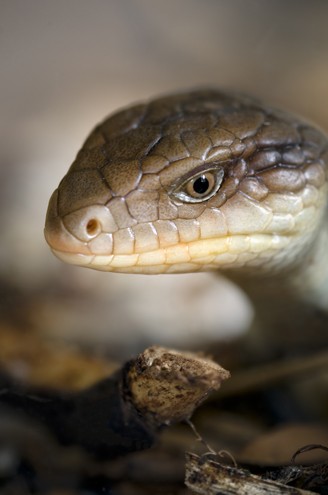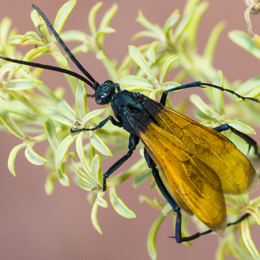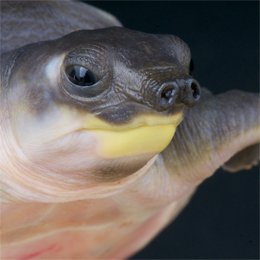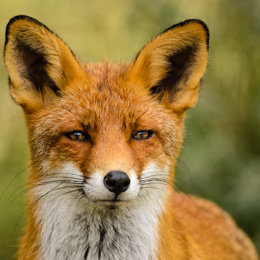Physical Description
The blue-tongued skink is a large, docile lizard that consists of a sturdily built body with an unusually large head. The skink displays distinct color patterns going from light brown streaks to various earthy tones of brown and silvery grey.
The most characteristic feature of the blue-tongued skinks is their large, flat and notched tongue, vividly berry blue in color present inside a bright pink mouth.
The stout tail of the blue-tongued skink is marked with dark cross bands, another feature that many biologists consider unique.
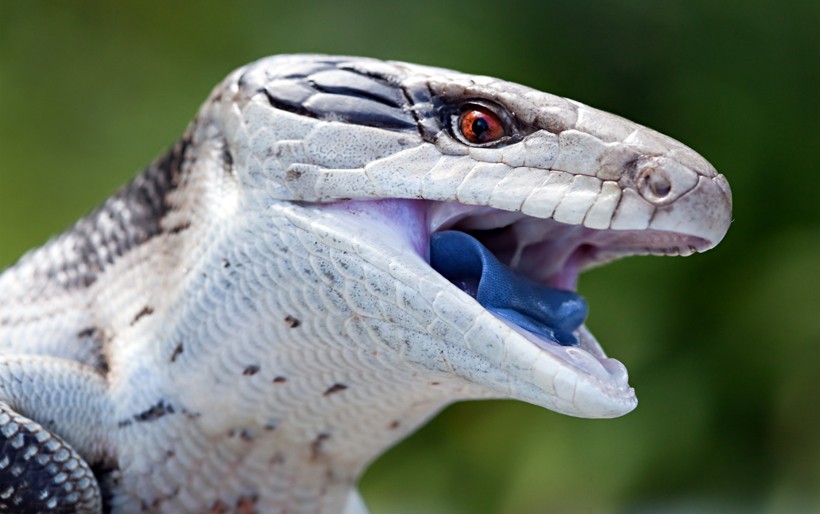
The famous vividly berry blue colored tongue
?
Image credits: Peter Waters/Shutterstock
Currently there are eight species of the common blue-tongued skink:- Australian Blue-tongued Skink
- Tanimbar Blue-tongued Skink
- Northern Blue-tongued Skink
- Eastern Blue-tongued Skink
- Western Blue-tongued Skink
- Central Blue-tongued Skink
- Blotched Blue-tongued Skink
- Shingleback
- Eastern Shingleback
- Rottnest Island Shingleback
- Shark Bay Shingleback
- Common Shingleback
- Pygmy Blue-tongued Skink
- Indonesian Blue-tongued Skink
- Merauke Blue-tongued Skink
- Key Island Blue-tongued Skink
- Irian Jaya Blue-tongued Skink
- Tanimbar Blue-tongued Skink
- Northern Blue-tongued Skink
- Eastern Blue-tongued Skink
- Eastern Shingleback
- Rottnest Island Shingleback
- Shark Bay Shingleback
- Common Shingleback
- Merauke Blue-tongued Skink
- Key Island Blue-tongued Skink
Size & Lifespan
The blue tongued skink can survive for about 20 years in captivity. In wild, however, almost all species have a lifespan of around 15-18 years.
This heavily bodied lizard showcases keeled scales and dark cross bands. It grows to an average size of 45-60 cm (1.47-1.9 feet) in length once it reaches adulthood. The average mass of the blue-tongued skink is 300-500 grams (0.75-1.12 lbs) and depends mostly upon the species and environmental conditions.
Anatomy
Blue-tongued skinks are extremely intelligent showcasing a resilient nature and are very docile creatures.
The bright blue fleshy tongue that contrasts with its pink mouth is a distinguishing feature especially when they hiss when threatened. The defensive mechanism of the blue, forked tongue is meant to ward off predators.
Except the Shingleback, all species of the blue-tongued skink consist of a smooth skin with overlapping scales.
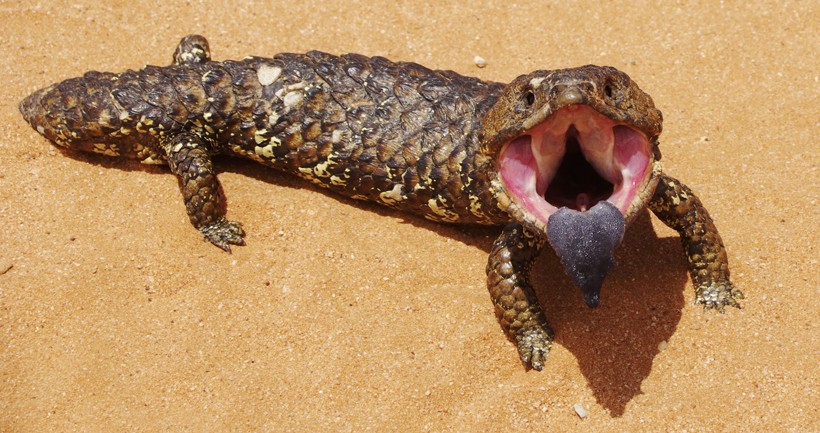
Only the shinglebacks have a rough skin
?
Image credits: Timothy Craig Lubcke/Shutterstock
The pale brown head, triangular in shape with a black dorsal side is usually imprinted with dark streaks or creamy blotches. This is a general pattern observed at most skinks belonging to this genus.
The blue-tongued skink maintains a hyoid skeleton with an almost cylindrical body that is supported by short legs. The tail of most blue-tongued skinks, like the Shingleback, resembles the head of a skink, hence, it is often referred to as the double-headed skink.
Ecdysis, also known as the periodic shedding of the skin by reptiles, is a commonly observed process in case of blue-tongued skinks. The dead keratinous skin is slowly cast off to permit future growth.
In terms of sexual dimorphism, it can be difficult to determine the gender since both males and females showcase similar coloring patterns. However male blue-tongued lizards have a relatively large head and robust body while females reserve a longer body and a short thick tail.
Like all reptiles, skinks also rely on the sense of smell by flicking their forked tongue to collect biochemical particles from the air. A sensory organ known as the Jacobson’s organ aligned with sensory cells in the palate helps the skink to detect subtle changes in the environment. The flicking of the tongue can occur as many as 300 times per hour.
Habitat
The majority of the blue-tongued skink population can be found in parts of Australia. Since they’re cold blooded, the blue-tongued skinks are unable to produce their own body heat. They need to maintain a body temperature of 30-35 degree Celsius. To compensate for this, the species rely mostly on warm surroundings to raise their body temperatures. Therefore, they thrive in open grasslands with ample sunlight in the midst of leaf litter, rocks and wood logs.
The blue-tongued skink is quite adaptable and can be found commonly in the garden of homeowners.
Though biogeographically, they are most prominent in Australia, the species also inhabit mixed woodland, semi-desert, scrubland and coastal plains of Tasmania and New Guinea.
The blotched blue-tongued lizard resides in southern most corners of Australia, in New South Wales and islands of the Bass Strait. The western blue-tongued skink which is near threatened can be found mostly in Victoria close to sparse woodlands. The pygmy blue-tongued, which is another species threatened by human invasion, is found in southern Australia, widely distributed in Peterborough, Hummocks and Kapunda.
Diet
Blue-tongued skinks feed on a variety of miniature plants, arthropods, snails and worms. Because they are highly agile, it becomes easy for them to catch prey like the common dragonflies in a single swift movement.
The animals they prey upon are mostly slow moving, like for example garden snails. Their large teeth can easily crush shells. The strong jaw bone simplifies grabbing insects like beetles and they may also feed on the larvae of insects.
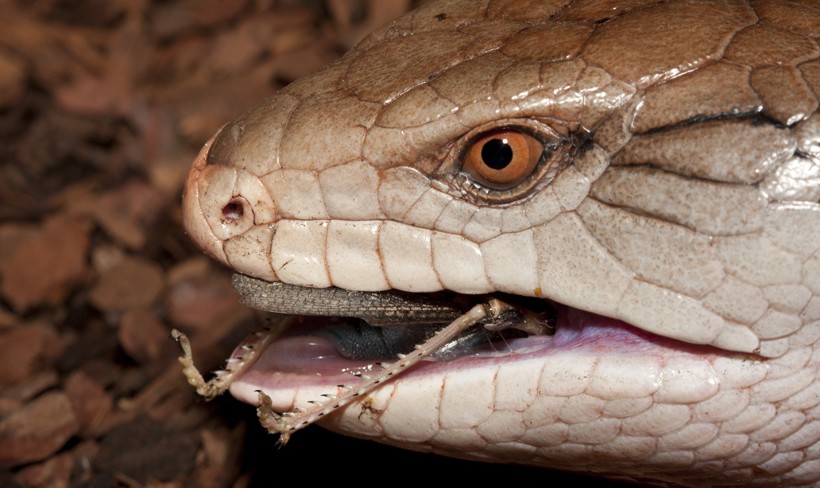
Blue-tongued skink eating a grasshopper
?
Image credits: Tallllly/Shutterstock
During the winter season, their metabolism reduces and they’re mostly inactive. They bury themselves within deep shelter sites and come out on sunny days to bask in the heat.
Captive studies have observed that most blue-tongued skinks also feed on fruits and vegetables when there is a scarcity of food. They can easily consume turnips, dandelions, collard greens etc and mostly exhibit a diurnal nature.
Predators
The blue-tongued skink falls prey to a number of animals, larger in size and more lethal in attack. Large predatory birds like the Laughing Kookaburras and the Brown Falcon, generally feed on the species. Venomous predators like the Eastern Brown snake and the Mulga snake also prey upon the blue-tongued skink. Likewise, feral cats and suburban dogs feed on the species and it has been found that the red fox particularly feeds on the western blue-tongued skink.
When threatened the blue-tongued skink exposes its large blue tongue by opening its mouth wide. This display and the large size of its head can ward off a few predators and sometimes the blue-tongued skink may also hiss and flatten its body as a precaution.
Behavior
Blue tongue skinks are solitary creatures, diurnal in nature and fairly docile showing little aggression. They do have a tendency to bite and latch on to the skin using their large teeth but the bite isn’t poisonous.
It displays a number of intricate defense mechanisms or bluff using its sharp blue tongue and flashing neon red lining of its mouth that is easily noticeable.
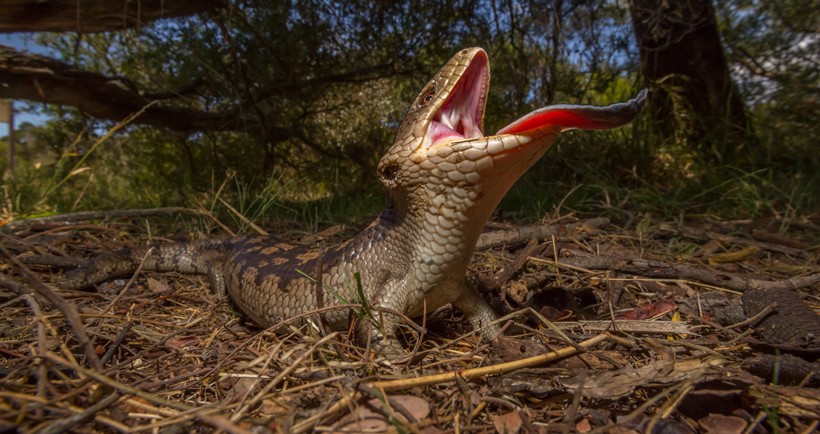
The blue-tongued skink scares its predators by showing the blue tongue
?
Image credits: Nathan Litjens/Shutterstock
Many scientists believe that the blue-tongued skink uses mimicry as a defense, which means that it mimics a few behavioral patterns and anatomical features of Death Adders (genus Acanthophis), a poisonous snake popularly found in Australia. This due to the short legs (snake look) and the color.
An unusual habit often observed from the blue-tongued skinks is when they feel threatened or frightened. In such a condition the skink may bite off its tail in order to escape from the scene. The tail heals and regenerates in a year’s time however the healing process is more dominant if the blue-tongued skink receives a lot of nutrition.
The blue-tongued skink is also able to expand its ribcage and turn on its side, which helps the reptile to look larger and thereby ward off predators.
The loss of the tail can actually cause many problems for the blue-tongued skink decreasing their potential to attract mates during the breeding season. It also reduces their ability to survive during winters since the tail is a fat reserve.
These lizards are territorial and attack opposing blue-tongued skinks if they feel the presence of any trespassers. During summer and spring, they are more active and frequently found when basking in the sun, foraging for foods and insects.
Reproduction
Blue-tongued skinks prefer a solitary life and it is only during the mating season that there is some form of interaction between male and female blue-tongued lizards. The mating season occurs in the months of September to November, a time during which males actually head out looking for prospective mates.
Male blue-tongued skinks compete for the same mate and this is an act of aggression, rarely witnessed otherwise in blue-tongued skinks. Sometimes female skinks may carry scrape marks produced from the male’s teeth that can occur during the act of submission.
A female blue- tongued skink has a gestation period of 100 days and does not lay eggs but showcasing internal fertilization. The reproduction is viviparous where the eggs mature and form embryos within the mother’s oviduct that is attached to the placenta. The birth of the young ones takes place normally in December and January.
The female gives birth to a litter of 10-25 baby skinks that are fully functional at birth reaching adulthood in around three years. Baby skinks generally don’t mature along their mothers side. After a few weeks of taking mother’s care, the young ones wander off on their own in search of food.
At birth, baby skinks feed on placental membranes and after a few days experience their first shed. Of all the blue-tongued skink species, the Eastern blue-tongued lizard has the largest litter, each measuring 13-14 cm (0.4-0.5 feet) with an average weight of 1 gram.
The young ones easily become prey for suburban dogs and predatory birds like the Laughing Kookaburras. This is why most baby skinks found in suburban gardens are not reaching adulthood.
(Sub)species and Geographical Distribution
While most behavioral characteristics, feeding adaptations and the reproductive cycle of the blue-tongued species remain the same, there are certain morphological differences that make each species unique.
Australian blue-tongued Skink (Tiliqua scincoides)
The most commonly found species in Australia are the Eastern and Northern blue-tongued skinks, of which the latter is the largest and heaviest of all blue-tongues in the family Scincidae.
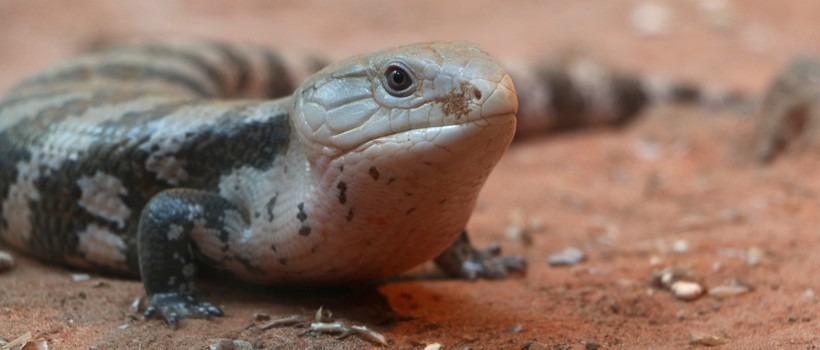
Eastern blue-tongued skink
?
Image credits: Skyprayer2005/Shutterstock
- Eastern blue-tongued skink (Tiliqua scincoides scincoides)
The Eastern blue-tongued skink (Tiliqua scincoides scincoides) often found in bush land conditions is slow, stout and showcases brown or grey scales with a barred pattern.
This subspecies can reach an approximate length of 45-50 cm (1.4-16 ft) with an average weight of 450 gram (approx. 1 lb) similar to its northern counterpart.
This particular species occurs throughout New South Wales and extends west till Cobar. The eastern blue-tongued skink is also prominent in Sydney, across the coastal plains and in the lower half of the Blue Mountains.
The Eastern blue-tongued skink (Tiliqua scincoides scincoides) often found in bush land conditions is slow, stout and showcases brown or grey scales with a barred pattern.
This subspecies can reach an approximate length of 45-50 cm (1.4-16 ft) with an average weight of 450 gram (approx. 1 lb) similar to its northern counterpart.
This particular species occurs throughout New South Wales and extends west till Cobar. The eastern blue-tongued skink is also prominent in Sydney, across the coastal plains and in the lower half of the Blue Mountains.
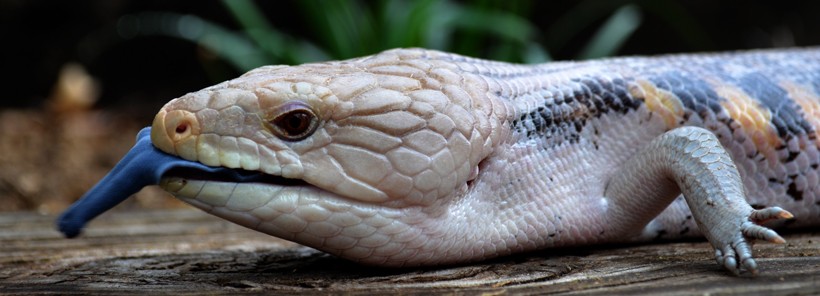
Northern blue-tongued skink
?
Image credits: Kassia Marie Ott/Shutterstock
- Northern blue-tongued skink (Tiliqua scincoides intermedia)
The Northern blue-tongued skink shows a distinctive coloring of a bright orange or soft peach body with dark stripes running along the sides. They can easily obtain a total size of 61 cm (2 feet) in length with a weight of 450 gram (approx. 1 lb).
This species is the largest of the world’s blue-tongued skinks that inhabit forested terrains of northern parts of Western Australia. Showcase a unique characteristic which is the transparent lower eyelids that protect their eyes from dust.
The Northern blue-tongued skink shows a distinctive coloring of a bright orange or soft peach body with dark stripes running along the sides. They can easily obtain a total size of 61 cm (2 feet) in length with a weight of 450 gram (approx. 1 lb).
This species is the largest of the world’s blue-tongued skinks that inhabit forested terrains of northern parts of Western Australia. Showcase a unique characteristic which is the transparent lower eyelids that protect their eyes from dust.
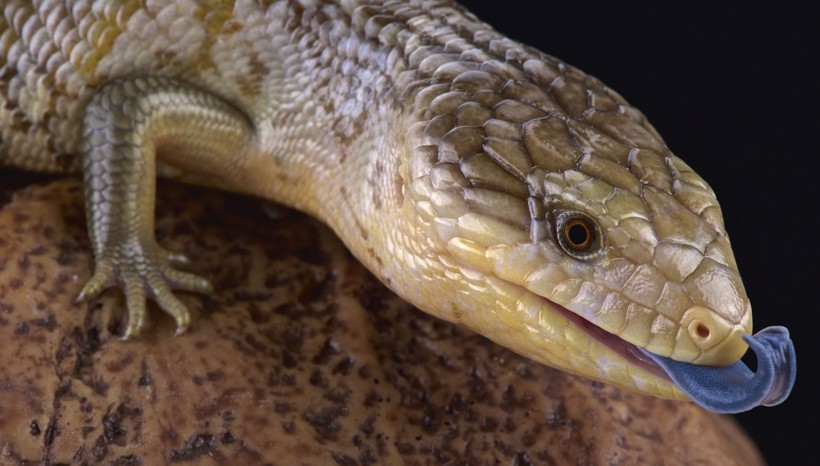
Tanimbar blue-tongued skink
?
Image credits: reptiles4all/Shutterstock
- Tanimbar blue-tongued skink (Tiliqua scincoides chimaerea)
This sub species is black/dark grey in color and can be found on the Tanimbar Island. Not much additional information is known regarding this sub species.
Shingleback (Tiliqua rugosa)
The Shingleback, with its dark blotches and rough scales, is the most unusual looking of all blue-tongued skink species.
The Shingleback consists of a heavily armored body and smooth, shiny scales that periodically shed off in the form of flakes for about six weeks, reducing metabolism rate. Unlike most skinks, this blue-tongued beauty with its gray colored body and dark stripes is widespread in semi-arid zones of the south and west of Australia.
In general, they inhabit drier parts or semi-arid regions of southern Australia that comprises of Bathurst in New South Wales and extends all the way into the coastal plains in western Australia. The thick tough skin adapts well to survive the harsh climate of the region with a particular liking for seasonal flowers, gorging on blossoms on a regular basis.
Also referred to as the bobtail, the Shingleback is characterized by its stumpy tail and lethargic body. Found in a variety of colors right from light cream to an earthy dark brown, this species has a varied length of 25-30 cm (0.8-1 ft). Unlike most blue-tongued skinks, this is the only species that cannot shed its tail.
There are four distinct subspecies of the Shingleback:
This sub species is black/dark grey in color and can be found on the Tanimbar Island. Not much additional information is known regarding this sub species.
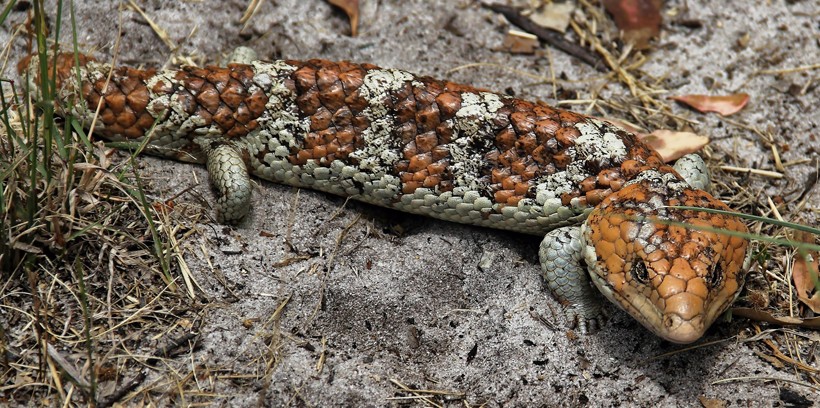
Western Shingleback
?
Image credits: HunnyCloverz/Shutterstock
- Western Shingleback (T. r. rugosa)
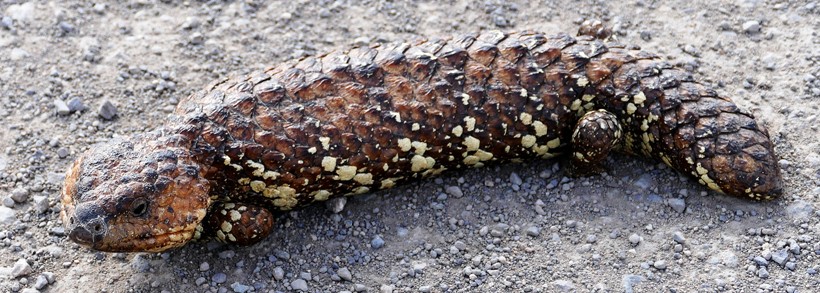
Eastern Shingleback
?
Image credits: PeterMooij/Shutterstock
- Eastern Shingleback (T. r. aspera)
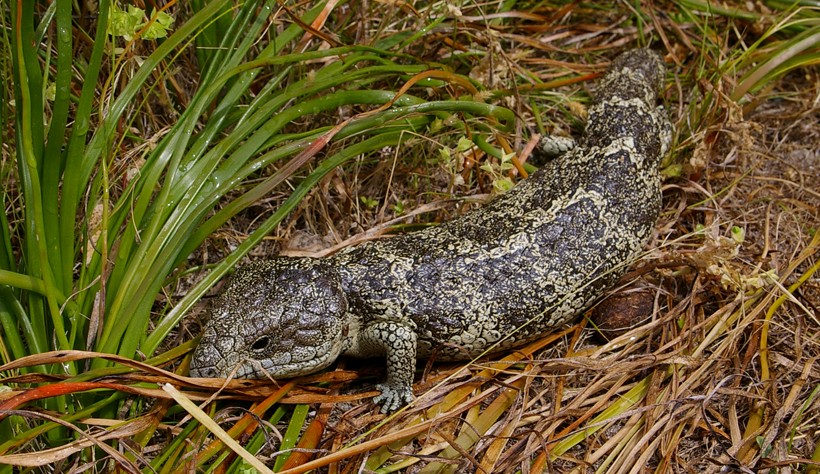
Rottnest Island Shingleback
?
Image credits: John Sullivan/Ribbit Photography
- Rottnest Island Shingleback (T. r. konowi)
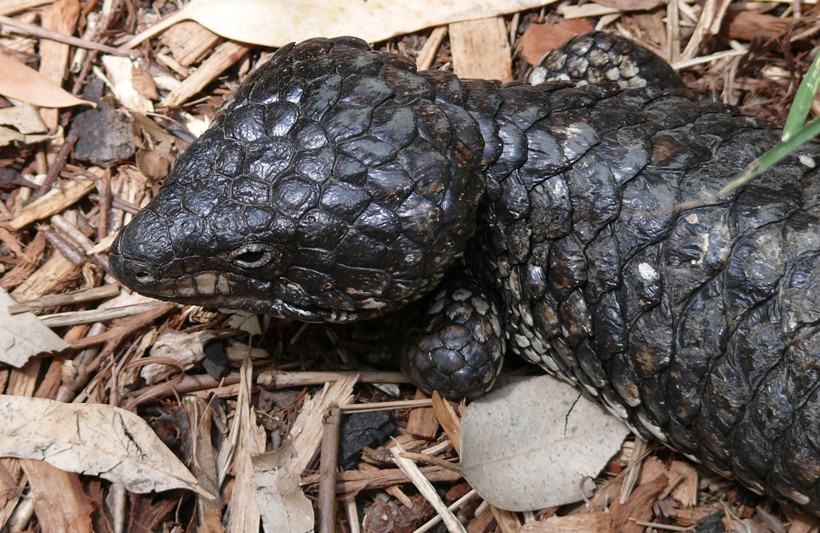
Shark Bay Shingleback
?
Image credits: Susan Flashman/Shutterstock
- Shark Bay Shingleback (T. r. palarra)
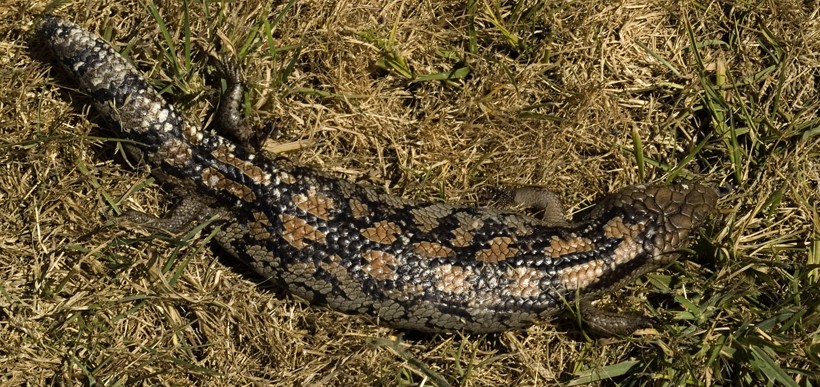
Blotched blue-tongued skink
?
Image credits: fritz16/Shutterstock
Blotched blue-tongued skink (Tiliqua nigrolutea)
Endemic to the southeastern parts of Australia, the blotched blue-tongued skink is another exceptional variety found in the species.
Coastal and montane woodlands are common habitats for the blue-tongued skinks that are also found in Tasmania and islands of Bass Strait. They are very well adapted to feeding on different kinds of vegetables, fruits and insects especially outdoor gardens in urban areas.
Also known as the southern blue-tongued skink, the species has an average size of 55 cm (1.8 ft) and doesn’t have any stripes on its skin. In fact, it is distinguishable from the rest because of the presence of irregularly shaped blotches on a pale brown or chocolate brown skin tone with tiny flecks around the face.
This species occurs mainly in Tasmania, in the lower latitudes found commonly in the north and east. The blotched blue-tongued skink inhabits the islands of Bruny, King, Great Dog, Maria etc. and can also be found in certain parts of Victoria in mainland Australia.
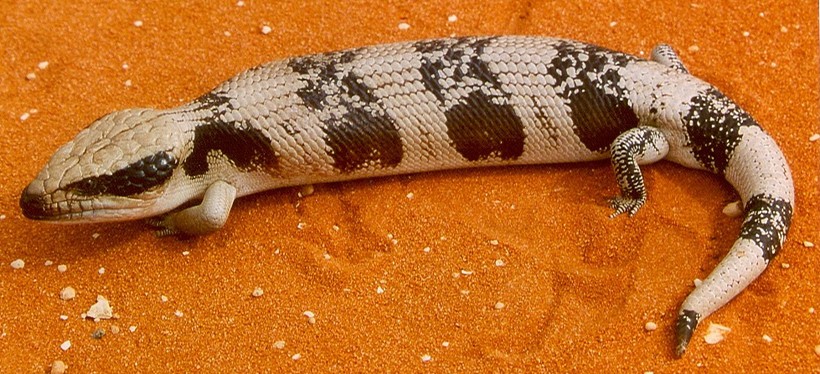
Western blue-tongued skink
?
Image credits: Public Domain
Western blue-tongued skink (Tiliqua occipitalis)
Native to western parts of Australia, this blue-tongued skink is a relatively large species that can grow to about 45 cm (1.47 ft) in length. The most distinctive feature of the species is the black markings near its eye and its banded patterns layered throughout the body surface.
This species is agile, with powerful jaws and can be found in shrublands, woodlands, deserts and dunes. It sometimes uses abandoned rabbit holes for shelter, alternatively, it rests under leaf litter.
The species gives birth to a maximum litter of five, unlike other species where the litter can be as large as twenty-five.
The species is, due to its small population density, Vulnerable in Victoria and Threatened in New South Wales according to the IUCN Red List.
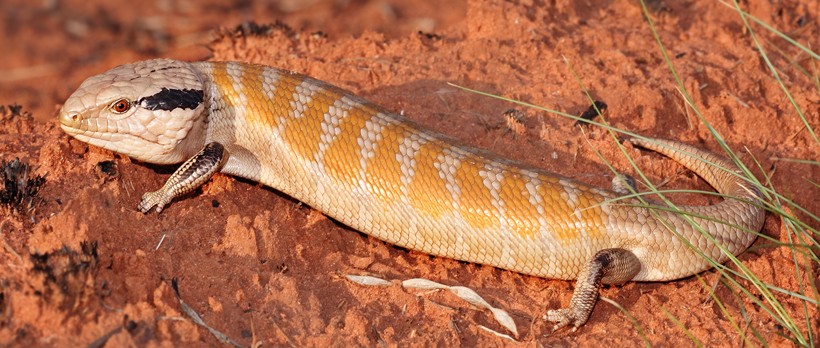
Centralia blue-tongued skink
?
Image credits: Ben Twist
Centralia blue-tongued skink (Tiliqua multifasciata)
This species is a rarity, with a golden brown coloration with a big brawny head and thick black temporal streaks that are present on each side of the head.
The typical locality of the species is Queensland, North Territory and New South Wales. It is generally found in sand dunes, open shrubland and hummock grasslands.
The Centralia blue-tongued skink can be distinguished by the presence of 11-13 orange bands, present on its robust body with an average litter size of around nine to ten young ones.
Currently, this species is being conserved in the Epping Forest National Park, Diamantina National Park and the Lochern National Park. It is fairly distributed in Queensland, New South Wales and Southern Australia.
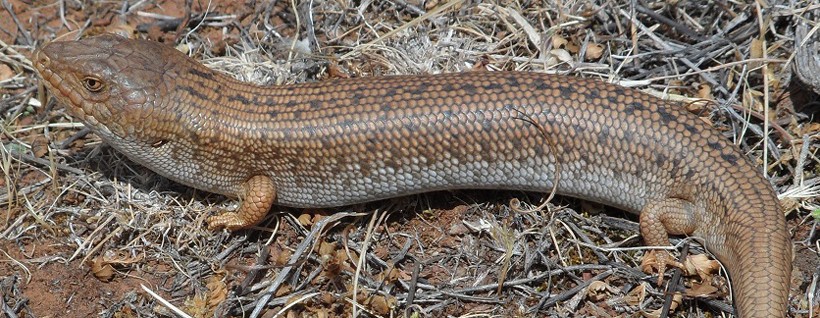
Adelaide Pygmy Skink
?
Image credits: John Fowler/reptilesofaustralia
Adelaide Pygmy Skink (Tiliqua adelaidensis)
Chocolate brown in color, this blue-tongued skink is mostly found in Adelaide. This rare species can grow to a total length of 20 cm (0.6 ft) featuring scattered dark brown/black blotches. It is, in fact, the smallest of the genus Tiliqua and unlike other members of the species, features a pink tongue.
One of the most popular habitats of the pygmy skink is spider holes that are 25 cm deep and considered as excellent for ambushing prey.
The spider holes are also be used as a nest for the young ones and basking sites for thermoregulation.
According to the IUCN and the National Parks and Wildlife Act, 1972, this species is listed as Endangered, due to the small population and limited habitat. It occurs in the temperate grasslands of South Australia, at Yongala, Burra, Clare and lower slopes of hillsides.
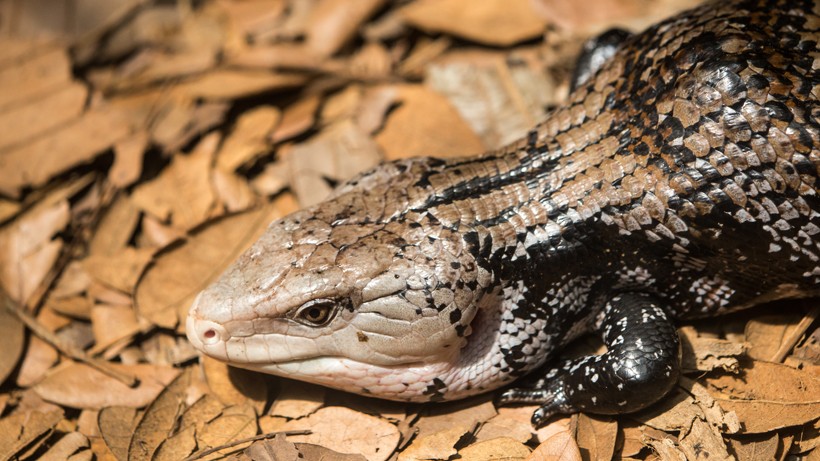
Indonesian blue-tongued skink
?
Image credits: CHAINFOTO24/Shutterstock
Indonesian blue-tongued skink (Tiliqua gigas)
This species has a distinct coloring of a grey body and black stripes, standing still on short solid black legs. The skink is a beautiful species of Indonesian origin, with a rugged exterior and a smooth shiny head.
They can be found in a variety of colors ranging from yellow-green to orange. However, all showcase short black legs and narrow horizontal black stripes. Endemic to the island of New Guinea, the typical habitat of the Indonesian blue-tongue is a rainforest.
The Indonesian blue-tongued skink is a tropical species that is of lower risk, as confirmed by the IUCN. The skink is popularly found on the island of Papua New Guinea. Despite being bred in captivity, the lifespan of this particular species can still be about 17.5 years with proper nutrition.
Two sub-species are present of its kind:
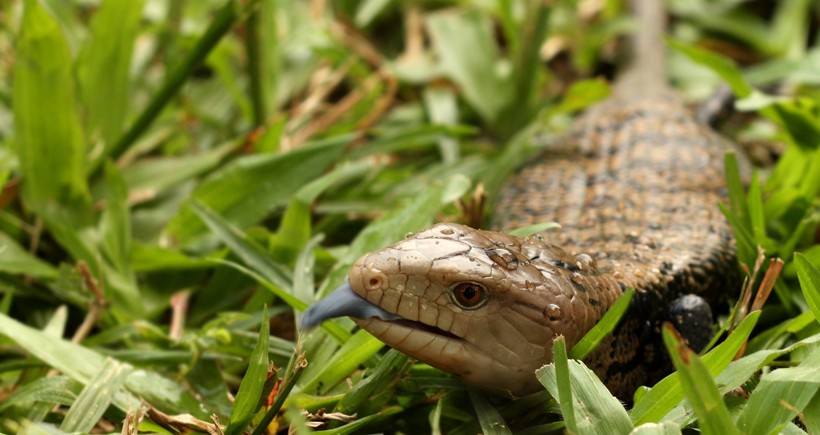
Merauke blue-tongued skink
?
Image credits: Lenice Harms/Shutterstock
- Merauke blue-tongued skink (T. g. evanescens)
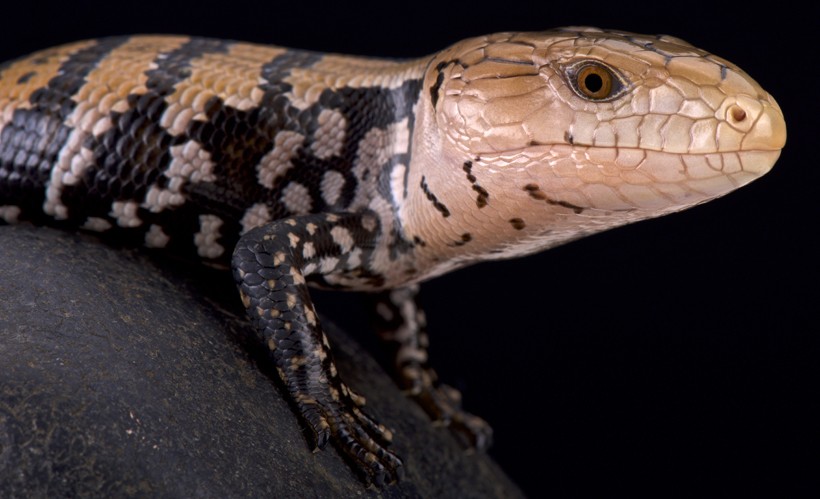
Kei island blue tongued skink
?
Image credits: reptiles4all/Shutterstock
- Key Island blue-tongued skink (T. g. keyensis)
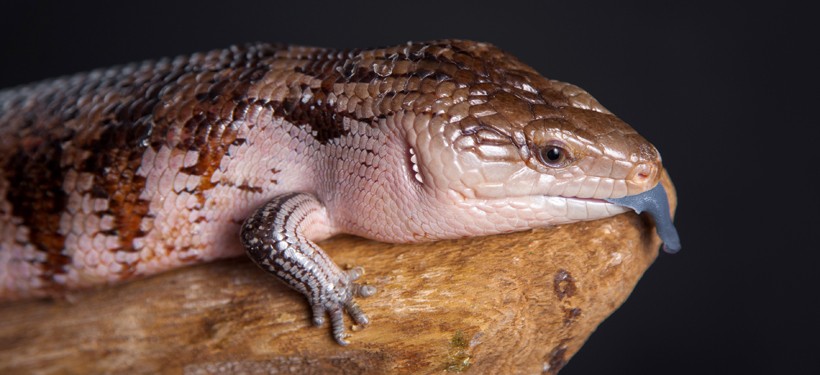
Irian Jaya Blue-tongued Skink
?
Image credits: RJO Photo/Shutterstock
Irian Jaya Blue-tongued Skink (Tiliqua sp)
A rare species, the Irian Jaya hasn’t been scientifically classified although showcases physical attributes of both Indonesian and Australian blue-tongued skinks.
Measuring about 60 cm (2 ft), the skink displays a dark brown body with a light peach undertone. Unlike the rest of the blue-tongued skinks, this species is the least understood.
Conservation Status
Although the conservation status of the blue-tongued skink hasn’t been specified exactly, a few species are already facing several threats according to the IUCN Red List:
- Eastern Blue-tongued skink: Not evaluated
- Northern Blue-tongued skink: Not evaluated
- Western Blue-tongued skink: Near threatened
- Adelaide/Pygmy Blue-tongued skink: Endangered
- Indonesian Blue-tongued skink: Lower risk
- Blotched Blue-tongued skink: Endangered
- Shingleback: Least Concern
- Irian Jaya Blue-tongued skink: Not evaluated
- Centralia Blue-tongued skink: Not evaluated
Ecological Importance
Though blue-tongued skinks are relatively miniature in size and significance, they do play a certain role in the ecosystem. In suburban gardens, the blue-tongued skinks regulate agricultural pest population by consuming snails, beetles, nematodes etc. They also serve as hosts for many parasitic worms.
The conservation status of almost all blue-tongued lizards hasn’t been precisely evaluated since the species can adapt to a number of environmental changes.
Road kills and illegal pet trade, however, are severe threats to their population. Many blue-tongued skinks are captured and sold by poachers illegally in indigenous areas. They are often killed because they resemble the Death Adder which can, in turn, be a disadvantage when the skinks enter human territories.
Habitat loss due to shrinkage and fragmentation of rainforests and grasslands may also contribute to the fact that the blue-tongued skink enters suburban areas where cats and dogs can prey upon it easily.
Funfacts
- The movement of blue-tongued skinks is referred to as the ‘waddle’.
- A blue-tongued skink’s tail can easily fall off and can grow back within a year’s time.
- Displays autotomy, where blue-tongued skinks drop their tails when they feel threatened.
- Blotched blue tongue skink is one of the few that has been identified from the Pleistocene fossil sites found at the Naracoorte Caves National Park.
- The Shingleback (Tiliqua rugosa) is the only species of the blue-tongued skinks that is colonial in nature and least aggressive with colony members.
- The Blotched blue-tongued skink is Tasmania’s largest lizard.
- The Shingleback mates with a single partner for the rest of its life, producing 2 large babies in a year.
